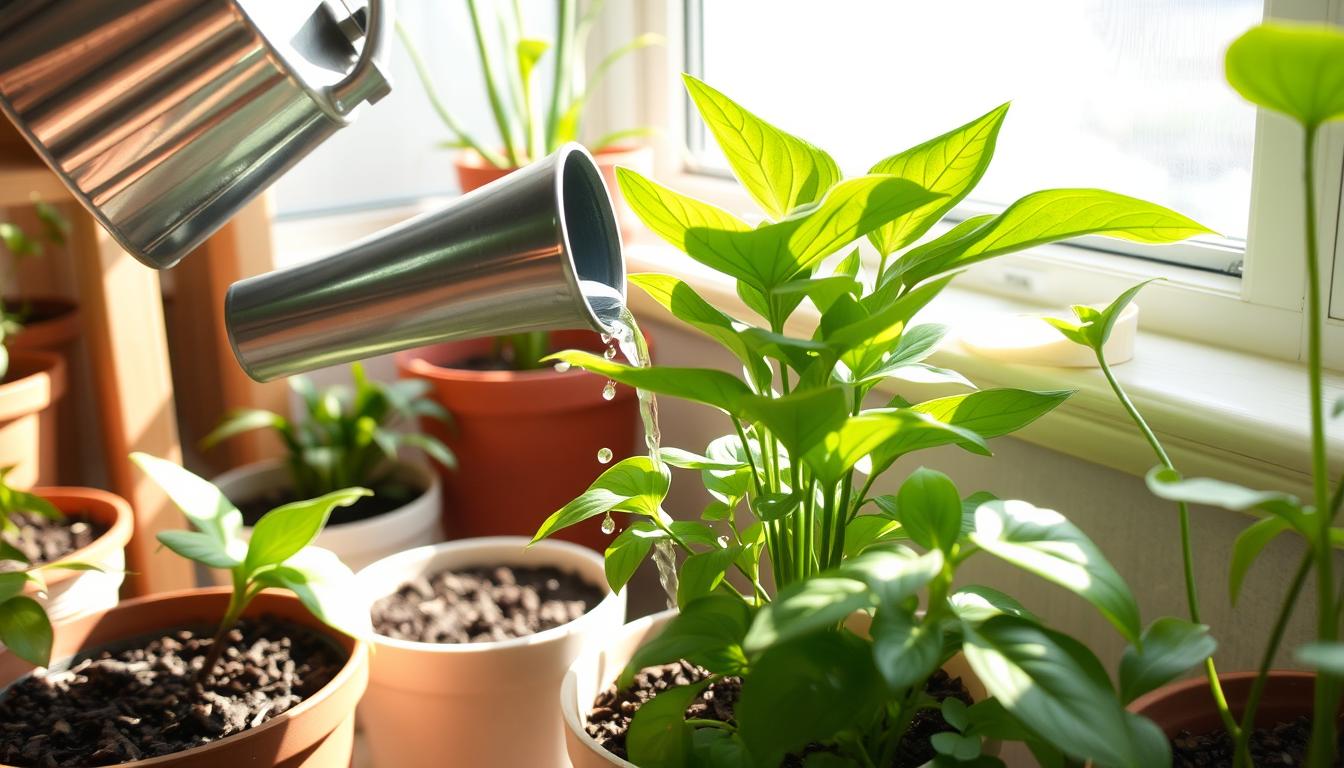As an indoor gardener, I’ve learned how crucial proper watering is for my houseplants. It’s not just about giving them water; it’s about doing it right. In this article, I’ll share tips and techniques to make you a pro at watering your indoor plants.
Key Takeaways
- Use the right watering tools, like a long-spout watering can, to reach the base of your plants
- Avoid using softened water, which can harm plants; opt for filtered, purified, or rainwater instead
- Water plants as needed, based on soil moisture, rather than following a rigid schedule
- Thoroughly soak the soil until water drains out of the pot’s drainage holes
- Understand the specific watering needs of different plant varieties and adjust according to seasonal changes
Understanding Houseplant Water Needs
Proper watering is key for keeping houseplants healthy. But, not all plants need the same amount of water. Knowing what your indoor plants need is crucial for their well-being.
Identifying Signs of Overwatering and Underwatering
Tropical plants like philodendrons need more water than desert plants like cacti and succulents. The season also changes how much water plants need. Most plants need more water in spring and summer.
To know when to water, check the soil moisture by sticking your finger into the potting mix. If it feels dry, it’s time to water. Too much water can cause yellow leaves, no new growth, and root rot. Not enough water can make leaves wilt, droop, and turn crispy. A plant moisture meter can help you figure it out.
| Signs of Overwatering | Signs of Underwatering |
|---|---|
| Yellowing leaves | Wilting, drooping leaves |
| Lack of new growth | Crispy, brown leaves |
| Root rot | Slow growth |
Understanding your houseplants’ moisture levels and water needs helps keep them healthy. Pay attention to the signs and adjust your watering as needed.
How to Water Your Houseplants Properly
Properly watering your houseplants is key to their health and life span. The main idea is to soak the soil well until water flows out of the drainage holes at the pot’s bottom. This method helps with root growth and prevents overwatering or underwatering.
Don’t just sprinkle a little water on the surface. It won’t reach the roots well. Water your plants in the morning. Let any extra moisture on the leaves dry during the day to avoid disease. If you add too much water, use a turkey baster to take out the extra potting soil.
For plants like cacti and African violets that don’t like wet soil, try bottom-watering. Put the pot in a saucer of water. Let the plant soak up moisture from the base. This keeps the plant health and moisture levels just right.
| Watering Technique | Best for | Benefits |
|---|---|---|
| Thoroughly soaking soil | Most houseplants | Encourages strong root development, prevents over/underwatering |
| Bottom-watering | Plants that don’t like wet soil (e.g., cacti, African violets) | Ensures optimal moisture levels without risk of overwatering |
Understanding your plants’ water needs is crucial for houseplant care. Adjust your watering schedules based on their needs. By doing this, you can keep your indoor plants healthy and happy.

Conclusion
Learning how to care for plants and keep houseplants healthy is a journey. With the right methods, your indoor garden will flourish. Knowing how much water your plants need and spotting signs of over-watering and under-watering makes you a pro at houseplant maintenance.
Check the potting soil moisture often and water until water drains out. Adjust your watering schedule as needed for each plant and season. Also, consider the drainage requirements and potting mix qualities of your plants. The right potting soil moisture is key for their drought tolerance and health.
With patience, practice, and attention to detail, you’ll keep your indoor garden thriving. Following these easy plant care tips helps you avoid over-watering and under-watering signs. This way, your houseplant maintenance will stay on track for many years.
FAQ
What are the essential tools and materials for properly watering indoor plants?
You’ll need a watering can with a long spout, filtered or purified water, and the right potting mix. Make sure it has good drainage.
How do I know when to water my houseplants?
Check the soil moisture by sticking your finger into the potting mix. If it feels dry, it’s time to water. Remember, different plants and seasons have different needs.
What are the signs of overwatering and underwatering houseplants?
Overwatering can cause yellowing leaves, no new growth, and root rot. Underwatering leads to wilting, drooping, and crispy leaves. A moisture meter can help you figure out when to water.
How should I water my houseplants?
Soak the soil until water drains out of the pot’s holes. But don’t let plants sit in water. Water in the morning and adjust as needed with the seasons.
What are some tips for preventing over- or underwatering my houseplants?
Don’t use softened water, which can be bad for plants. Check the soil moisture often and water when needed, not just on a schedule. Use the bottom-watering method for plants that prefer dry soil.






